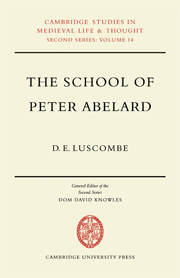Book contents
- Frontmatter
- Contents
- Preface
- List of Abbreviations
- I The Literary Evidence
- II Abelard's Followers
- III The Diffusion of Abelardian Writings
- IV The Condemnation of 1140
- V The Theological Writings of Abelard's Closest Disciples
- VI The School of Laon
- VII Hugh of St Victor
- VIII The Summa Sententiarum
- IX Abelard and the Decretum of Gratian
- X Abelard's Disciples and the School of St Victor
- XI Peter Lombard
- XII Robert of Melun
- XIII Richard of St Victor
- XIV Conclusion
- Appendices
- Bibliography
- Index of Manuscripts
- General Index
- Frontmatter
- Contents
- Preface
- List of Abbreviations
- I The Literary Evidence
- II Abelard's Followers
- III The Diffusion of Abelardian Writings
- IV The Condemnation of 1140
- V The Theological Writings of Abelard's Closest Disciples
- VI The School of Laon
- VII Hugh of St Victor
- VIII The Summa Sententiarum
- IX Abelard and the Decretum of Gratian
- X Abelard's Disciples and the School of St Victor
- XI Peter Lombard
- XII Robert of Melun
- XIII Richard of St Victor
- XIV Conclusion
- Appendices
- Bibliography
- Index of Manuscripts
- General Index
Summary
This book represents an historian's attempt to discern the ways in which Abelard's thought reached and influenced his contemporaries and successors. The subject has attracted historical study for nearly a century if we take as a starting point the classic article by Heinrich Denifle entitled ‘Die Sentenzen Abaelards und die Bearbeitungen seiner Theologia vor Mitte des 12. Jahrhunderts’ which appeared in the Archiv fur Literatur– und Kirchen-geschichte des Mittelaltcrs in 1885. Since that time much further knowledge of Abelard's school and of his disciples has accumulated and in addition a vast amount of scholarly energy has been devoted to the task of understanding and of bringing to life twelfth-century thought and learning in its many aspects and moods. With respect to Abelard's following it is perhaps a fitting time to draw together some threads and to offer an interpretation of its place in the evolution of the early scholastic movement.
The principal sources of this study are literary, biographical, palaeographical and doctrinal. The occasional surviving literary references to Abelard which were made in the twelfth century and later are numerous enough to convey the intensity and the scale of the disagreements which existed concerning his personality and achievement. The names of several of his disciples and hearers are also known and an examination is here attempted of their relationships to Abelard as well as of their reactions to his work and thought. However, information concerning twelfth-century personalities is seldom abundant and much can also be gained from studying the codicology of Abelard and his school.
- Type
- Chapter
- Information
- The School of Peter AbelardThe Influence of Abelard's Thought in the Early Scholastic Period, pp. ix - xiPublisher: Cambridge University PressPrint publication year: 1969

